Common names from other countries
>
Eupercaria/misc (Various families in series Eupercaria) >
Priacanthidae (Bigeyes or catalufas)
Etymology: Pristigenys: Greek, pristis = saw + Greek, genys, -yos = face (Ref. 45335).
More on author: Cuvier.
Environment: milieu / climate zone / depth range / distribution range
Ecologia
marinhas associadas(os) a recifes; intervalo de profundidade 1 - 250 m (Ref. 100719), usually 5 - 30 m (Ref. 94109). Tropical
Western Pacific: Japan, East China Sea Shelf, Taiwan, South China Sea, Vietnam, Celebes, Australia, and Indonesia.
Tamanho / Peso / Idade
Maturity: Lm ? range ? - ? cm
Max length : 27.4 cm SL macho/indeterminado; (Ref. 5403)
Espinhos dorsais (total) : 10; Raios dorsais (total) : 11; Espinhos anais: 3; Raios anais : 10; Vértebras: 23. This species is distinguished from its congeners by the following set of characters: D X,11; A III,10; total gill rakers on first arch 27-31, mode 27 (upper limb 7-10, lower 19-22); lateral-line scales 31-39, mode 35; body scales above pectoral fin with about 11-60 spinules on posterior margin, the number increasing with growth; generally rounded caudal fin in young, becoming somewhat double emarginate in adults (noticeable in specimens over 15.0 cm SL); absence of black margins on posterior soft portions of vertical fins; 5 white or pale vertical bands (often indistinct) on body about 1/2-3/5 width of pupil expanded ventrally and dorsally with latter angled posterodorsally, very notable in young, less obvious in adults (Ref. 94109).
Associated with rocky habitats and known from 80 to more than 100 m depth but probably also occurring in shallower water, especially as juveniles (Ref.5403). From dive observations, juveniles and young individuals likely occur at 5-30 m depths (Ref. 94109). Eggs are pelagic (0.75 mm), small and spherical.
Ciclo de vida ou comportamento de acasalamento
Maturities | Reprodução | Spawnings | Egg(s) | Fecundities | Larvas
Iwatsuki, Y., T. Matsuda, W.C. Starnes, T. Nakabo and T. Yoshino, 2012. A valid priacanthid species, Pristigenys refulgens (Valenciennes 1862), and a redescription of P. niphonia (Cuvier in Cuvier & Valenciennes 1829) in the Indo-West Pacific (Perciformes: Priacanthidae). Zootaxa 3206:41-57. (Ref. 94109)
Status na Lista Vermelha da UICN (Ref. 130435)
CITES (Ref. 128078)
Not Evaluated
Ameaça para os humanos
Harmless
Uso pelos humanos
Pescarias: espécies comerciais
Ferramentas
Relatórios especiais
Baixar XML
Fontes da internet
Estimates based on models
Preferred temperature (Ref.
115969): 20.8 - 28.9, mean 27.6 (based on 972 cells).
Índice de diversidade filogenética (Ref.
82804): PD
50 = 0.5313 [Uniqueness, from 0.5 = low to 2.0 = high].
Bayesian length-weight: a=0.02239 (0.00929 - 0.05398), b=2.93 (2.73 - 3.13), in cm Total Length, based on LWR estimates for this (Sub)family-body shape (Ref.
93245).
Nível Trófico (Ref.
69278): 3.9 ±0.5 se; based on size and trophs of closest relatives
Resiliência (Ref.
120179): Elevada, tempo mínimo de duplicação da população menor que 15 meses (Preliminary K or Fecundity.).
Fishing Vulnerability (Ref.
59153): Low vulnerability (23 of 100).
